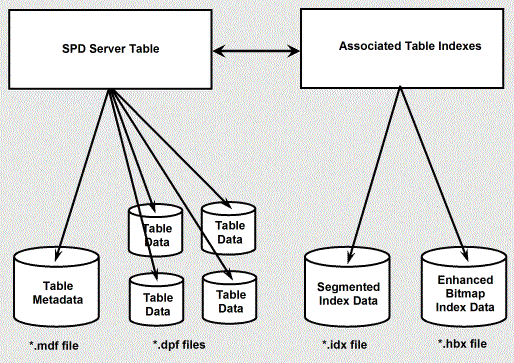Organizing SAS Data
SPD Server Tables
SPD Server software
alters SAS tables to enable high-performance processing. SPD Server
tables are physically different from a Base SAS table. You can use
tables in either SAS or native SPD Server format. Accessing and Creating SAS Scalable Performance Data (SPD) Server Tables discusses how a simple PROC COPY statement handles Migrating Tables between SAS and SPD Server.
SAS tables store a single
file that contains the data descriptors and the table data. The data
are column values. The descriptors are metadata that describe the
column and data formatting that the table uses.
SPD Server tables do
not reuse space. When an SQL command to delete one or more rows from
a table is issued, the row is marked deleted and the space is not
reused. To recapture the space, the table must be copied.
SPD Server Component Files shows differences in the architecture between SPD Server
tables and SAS tables. SPD Server uses component files to store tables.
One component file stores the stream of data values. Another component
file stores the column and data descriptors. If you create an index
for a column or a composite of columns, SPD Server creates component
files for each index.
SPD Server Component Files
SPD Server uses four
types of component files to store SPD Server tables. SPD Server Component Files shows the components of SPD Server tables. Two component
files store table information. The *.dpf component file stores a stream
of the table's data values. The *.mdf component file stores the table's
metadata. SPD Server creates two more component files to manage index
data. *.hbx components are unique global B-tree indexes. *.idx components
are segmented views of the indexed column data. The *.idx components
are especially useful in evaluating parallel WHERE clauses.
SPD Server partitions
component files when they are created to prevent them from growing
too large. Each partitioned component file is stored as one or more
disk files. There are several advantages to partitioning the component
files.
-
Multiple Directory Paths: SPD Server can access data libraries that span numerous directory paths and storage devices. SPD Server software partitions massive data libraries into component files. The component architecture enables rapid threaded data access, while circumventing device capacity and file size limitation issues. Storage lists transparently track component file locations so users can access multiple storage devices as a single volume, even if file partitions exist in different locations.
-
Flexibility in Storage: There is no need to store data tables and associated indexes in the same location when using SPD Server component files. Data files and associated indexes can be stored in different directory structures or on different devices if you want. When deciding where to store component SPD Server tables, you only need to consider the cost, performance, and availability of the disk space.
-
Improved Table Scan Performance: Data component partitions that are created using fixed-size intervals perform aggressively during parallelized full-table scans. SPD Server Table Options contains information about how to use the PARTSIZE= option to control partition size.
SPD Server Table Indexes
SPD Server allows you
to create indexes on table columns. SPD Server can thread WHERE clause
evaluations for tables that are not indexed. Indexes enable rapid
WHERE clause evaluations. In particular, large tables should be indexed
to exploit SPD Server performance. For more information about SPD
Server indexes, see Indexing a Table.
